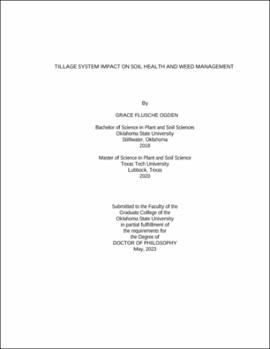| dc.contributor.advisor | Warren, Jason | |
| dc.contributor.author | Flusche Ogden, Grace | |
| dc.date.accessioned | 2023-08-30T19:45:01Z | |
| dc.date.available | 2023-08-30T19:45:01Z | |
| dc.date.issued | 2023-05 | |
| dc.identifier.uri | https://hdl.handle.net/11244/339003 | |
| dc.description.abstract | The first chapter of this dissertation involves two studies that were conducted from 2022-2023 to determine the impact of sweep tillage on soil health and management of tumble windmill grass (Chloris verticillata). The first study, Occasional Sweep, compared a single application of sweep tillage + herbicide to herbicide alone (no-tillage) and tillage alone (disk) to determine the most effective option to manage tumble windmill grass. The second study, Multiple Sweep, evaluated tumble windmill grass control and soil response following one, two, or three passes of sweep tillage in comparison to herbicide alone in no-till. Soil response to a single application of sweep tillage was statistically similar to no-tillage in terms of aggregate stability, CO₂ emissions, volumetric water content, and soil organic matter in both studies. Sweep tillage + herbicide provided ≥92% control across all years. Treatments of herbicide alone in no-till did not provide visual control >88% in either study across all years. Disk tillage controlled tumble windmill grass ≥87% across all years but poses a significant risk in terms of soil erosion. | |
| dc.description.abstract | The second chapter of this dissertation evaluates the impact of soil surface residue, as influenced by tillage, on delayed preemergence herbicides in winter wheat for Italian ryegrass (Lolium multiflorum) management. Tillage treatments included no-tillage, sweep tillage, and disk tillage. No relationship was observed between tillage system and herbicide efficacy for Italian ryegrass control, indicating soil surface residue as influenced by tillage did not impact the efficacy of delayed preemergence herbicides in winter wheat. Furthermore, no differences in soil response was observed among tillage systems until after three years of consecutive tillage. Ryegrass control greater than 86% was achieved in May 2020, 2021, and 2022 with treatments of pyroxasulfone + metribuzin and pyroxasulfone + pinoxaden. | |
| dc.description.abstract | The third chapter of this dissertation describes curriculum development of a new course, Cropping Systems, and student perception shifts during the course. Student perceptions shifted from 19% of students perceiving Oklahoma farm progress negatively in pre-course surveys to 6% of students perceiving Oklahoma farm progress negatively in post-course surveys. Students benefitted from hands-on experiences and specialized guest lectures that reinforced classroom taught principles. | |
| dc.format | application/pdf | |
| dc.language | en_US | |
| dc.rights | Copyright is held by the author who has granted the Oklahoma State University Library the non-exclusive right to share this material in its institutional repository. Contact Digital Library Services at lib-dls@okstate.edu or 405-744-9161 for the permission policy on the use, reproduction or distribution of this material. | |
| dc.title | Tillage system impact on soil health and weed management | |
| dc.contributor.committeeMember | Haggard, Beatrix | |
| dc.contributor.committeeMember | De Oliveira Silva, Amanda | |
| dc.contributor.committeeMember | Jones, Rodney | |
| osu.filename | FluscheOgden_okstate_0664D_18152.pdf | |
| osu.accesstype | Open Access | |
| dc.type.genre | Dissertation | |
| dc.type.material | Text | |
| dc.subject.keywords | aggregate stability | |
| dc.subject.keywords | soil health | |
| dc.subject.keywords | sweep tillage | |
| dc.subject.keywords | tumble windmill grass | |
| dc.subject.keywords | weed management | |
| thesis.degree.discipline | Soil Science | |
| thesis.degree.grantor | Oklahoma State University | |
